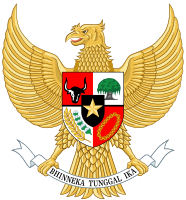
Guided Democracy was the political system in place in Indonesia from 1959 until the New Order began in 1966. It was the brainchild of President Sukarno, and was an attempt to bring about political stability. Sukarno believed that the parliamentarian system implemented during the liberal democracy period in Indonesia was ineffective due to its divisive political situation at that time. Instead, he sought a system based on the traditional village system of discussion and consensus, which occurred under the guidance of village elders. With the declaration of martial law and the introduction of this system, Indonesia returned to the presidential system and Sukarno became the head of government again.

The Order of Eleventh March, commonly referred to by its syllabic abbreviation Supersemar, was a document signed by the Indonesian President Sukarno on 11 March 1966, giving army commander Lt. Gen. Suharto authority to take whatever measures he "deemed necessary" to restore order to the chaotic situation during the Indonesian mass killings of 1965–66. The abbreviation "Supersemar" is also a play on the name of Semar, the mystic and powerful figure who commonly appears in Javanese mythology including wayang puppet shows. The invocation of Semar was presumably intended to help draw on Javanese mythology to lend support to Suharto's legitimacy during the period of the transition of authority from Sukarno to Suharto.

The Sixth Development Cabinet was the Indonesian cabinet which served under President Suharto and Vice President Try Sutrisno from March 1993 until March 1998. The Cabinet was formed after Suharto was elected to a 6th term as President by the People's Consultative Assembly (MPR).

The Fourth Development Cabinet was the Indonesian cabinet which served under President Suharto and Vice President Umar Wirahadikusumah from March 1983 until March 1988. The cabinet was formed after Suharto was elected to a 4th term as President by the People's Consultative Assembly (MPR).

The Third Development Cabinet is the name of the cabinet of the Indonesian government led by President Suharto and Vice President Adam Malik. The cabinet was announced on 29 March 1978 and served from 31 March 1978 until 16 March 1983.
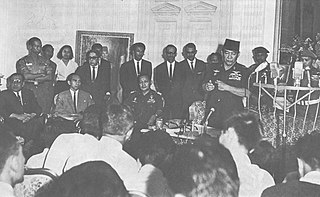
The Ampera Cabinet was the Indonesian cabinet which served under President Sukarno and later on Acting President Suharto from July 1966 until October 1967. The cabinet was formed after the Provisional People's Consultative Assembly (MPRS) session of 1966 which commissioned Suharto to form a new cabinet. Although Sukarno would not be removed from the presidency for some months, for all intents and purposes, the person who was truly in charge of the cabinet, and Indonesia by this point, was Suharto.

The Second Revised Dwikora Cabinet was the Indonesian cabinet which served under President Sukarno from March 1966 until July 1966. The cabinet was formed after Lieutenant General Suharto, using the powers that Sukarno gave to him through Supersemar, arrested 15 ministers from the Revised Dwikora Cabinet who were suspected of being sympathizers of the Indonesian Communist Party (PKI).

The Revised Dwikora Cabinet was the Indonesian cabinet which served under President Sukarno from February 1966 to March 1966. The cabinet was formed under an extremely tense political situation, and it was expected that this cabinet would address the concerns of the people. It was during a meeting of this cabinet that unidentified troops surrounded the Presidential Palace causing to Sukarno to escape to Bogor from where he gave Supersemar to Lieutenant General Suharto.
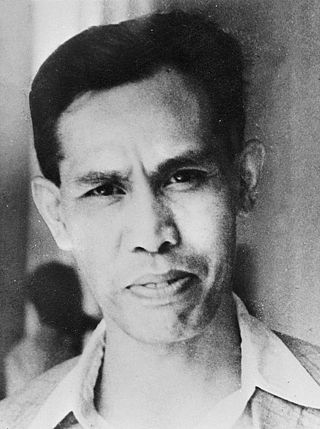
{{Leimena,is his Moluccan patronymic surname}}

The Cabinet of the Republic of Indonesia is part of the executive branch of the Indonesian government. It is composed of the most senior appointed officers of the executive branch of the government serving under the president. Members of the Cabinet serves at the president's pleasure, who can dismiss them at will for no cause.

The Second Hatta Cabinet was Indonesia's ninth cabinet. It was formed after the Indonesian leadership, which had been imprisoned by Dutch forces, returned to the capital, Yogyakarta. It served from 4 August to 20 December 1949.
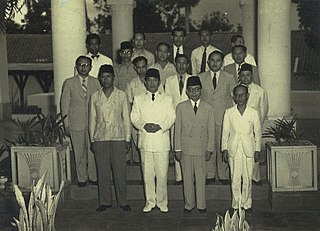
The Soekiman Cabinet, also known as the Sukiman-Suwirjo Cabinet, was an Indonesian cabinet that served from 27 April 1951 until it fell on 23 February 1952 following revelations that it had signed a mutual security agreement with the United States, and was dissolved on 3 April 1952.

The First Ali Sastroamidjojo Cabinet was an Indonesian cabinet named after the prime minister, and also known as 'Kabinet IV', that served from 30 July 1953 until 12 August 1955.
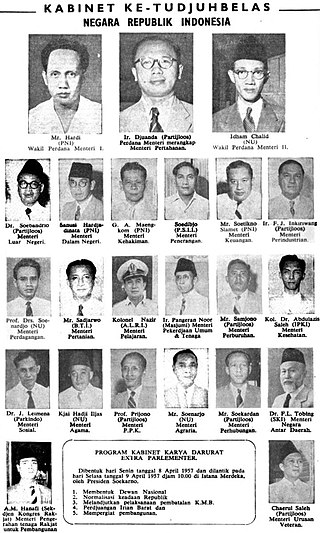
The Djuanda Cabinet, also known as the Working Cabinet, was an Indonesian cabinet that served from 9 April 1957 until 10 July 1959, when it was dissolved by a decree from President Sukarno.

The Second Working Cabinet was an Indonesian cabinet that served from 18 February 1960 until 6 March 1962, when President Sukarno reshuffled it.

The Fourth Working Cabinet was an Indonesian cabinet that resulted from regrouping of the previous cabinet by President Sukarno. It consisted of three deputy prime ministers, eight coordinating ministers, 33 ministers, six ministers of state, as well as 11 cabinet members who headed various government bodies. It was dissolved on 27 August 1964.

The Dwikora Cabinet was the 23rd Indonesian cabinet. President Sukarno reshuffled the previous cabinet on 27 August 1964 to produce a cabinet better able to implement the government policy he had announced in his Independence Day speech entitled "The Year of Living Dangerously". The cabinet was appointed on 2 September and served for a year and five months before being reshuffled on 21 February 1966.
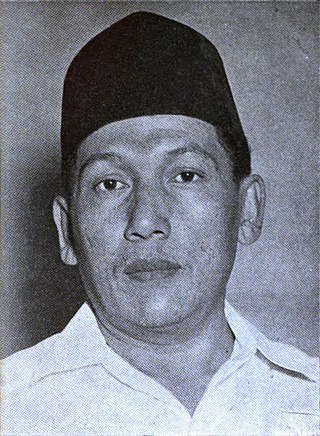
Kiai Haji Zainul Arifin was an Indonesian politician who served as deputy prime minister of Indonesia, 2nd Speaker of the DPR, and a leading figure of the Nahdlatul Ulama.

The First Working Cabinet was an Indonesian cabinet that served from 10 July 1959 until 18 February 1960, when President Sukarno reshuffled it.

Wiluyo Puspoyudo was an Indonesian military figure and politician who became the deputy speaker of the People's Consultative Assembly from 1960 until 1966, and as the acting Speaker of the People's Consultative Assembly in 1966.
